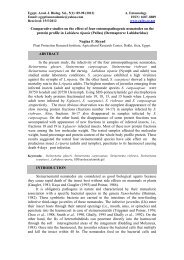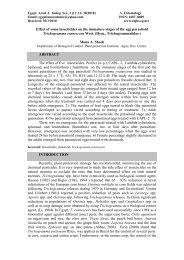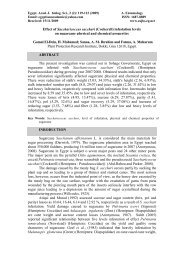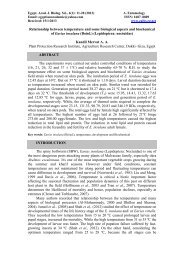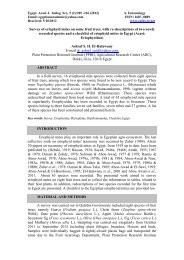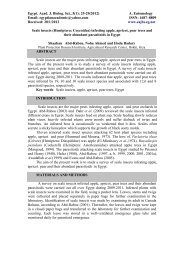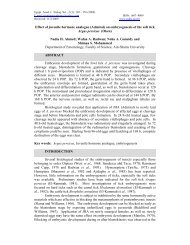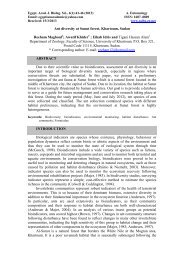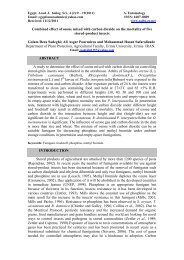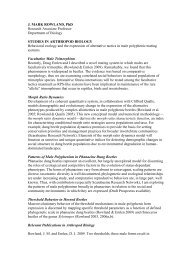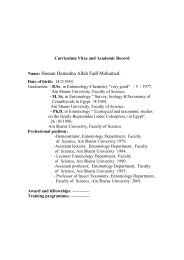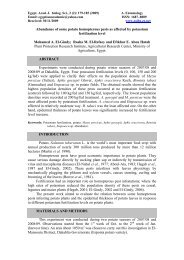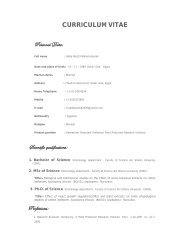Heat Requirements for the Development of the Black cutworm ...
Heat Requirements for the Development of the Black cutworm ...
Heat Requirements for the Development of the Black cutworm ...
Create successful ePaper yourself
Turn your PDF publications into a flip-book with our unique Google optimized e-Paper software.
120<br />
Hassan F. Dahi et al.<br />
The three observed values <strong>for</strong> larval rate <strong>of</strong> development at rang <strong>of</strong><br />
temperature from 20 to 30C, gave also a remarkable good fit to <strong>the</strong> calculated<br />
temperature – velocity line having <strong>the</strong> <strong>for</strong>mula Y =0.33 x -3.51 (Fig.2).<br />
Table (2): <strong>Development</strong> <strong>of</strong> A. ipsilon larvae under different constant temperatures and its <strong>the</strong>rmal requirements.<br />
Temp.<br />
( °C)<br />
Larvae duration<br />
(days ± S.E)<br />
Expected<br />
duration<br />
(days)<br />
Rate <strong>of</strong><br />
development %<br />
Expect rate<br />
<strong>of</strong><br />
development<br />
%<br />
20 33.06 ± 0.32 a 32.36 3.02 3.09<br />
to<br />
(˚C)<br />
Degree<br />
days<br />
(dd΄s)<br />
309.8<br />
25 20.49 ± 0.33 b 21.14 4.88 4.73 10.63 294.4<br />
30 15.81 ± 0.12 c 15.65 6.32 6.39 306.2<br />
Average 303.5<br />
L.S.D 0.43<br />
Fig. (2): The regression line <strong>of</strong> <strong>the</strong> relation between <strong>the</strong> rate <strong>of</strong> development <strong>of</strong> A. ipsilon larvae and<br />
different constant temperatures.<br />
Pupal stage<br />
Concerning <strong>the</strong> effects <strong>of</strong> <strong>the</strong> three tested constant temperatures on <strong>the</strong><br />
pupal duration <strong>of</strong> A. ipsilon (Table 3) it is noticed generally that <strong>the</strong> pupal period<br />
decreased as temperature increased from 20 to 30C. The average durations were<br />
18.15, 12.00 and 9.12days at 20, 25 and 30 C, respectively. Statistical analysis<br />
referred to significant differences (P < 0.01) between <strong>the</strong> pupal duration and <strong>the</strong><br />
tested constant temperatures.<br />
Table (3): <strong>Development</strong> <strong>of</strong> A. ipsilon pupae under different exposure <strong>of</strong> constant temperatures and its relation<br />
with <strong>the</strong>rmal requirements.<br />
Temp.<br />
( °C)<br />
R a t e o f d e v e(1/t l o px1m 0 ) e0n t<br />
Pupal duration<br />
(days ± S.E)<br />
Expect duration<br />
(days)<br />
Rate <strong>of</strong><br />
developme<br />
nt<br />
Expect rate <strong>of</strong><br />
<strong>Development</strong> %<br />
20 18.15 ± 0.15 a 18.05 5.51 5.54<br />
to<br />
(˚C)<br />
Degree Days<br />
(DD΄s)<br />
184.6<br />
25 12.00 ± 0.06 b 12.1 8.33 8.26 9.83 182.0<br />
30 9.12 ± 0.09 c 9.09 10.96 10.99 184.0<br />
Average 183.5<br />
L.S.D 0.42<br />
8<br />
7<br />
6<br />
5<br />
4<br />
3<br />
2<br />
1<br />
0<br />
r = 0 . 9 9 K = 3 0 3 . 5<br />
y = 0 . 3 3x<br />
-3 . 5 1<br />
0 5 1 0 1 5 2 0 2 5 3 0 3 5<br />
T e m p e r a t u r e ( ° C)<br />
F i g . ( 2 ) : T h e r e g r e s s i o n l i n e o f t h e r e l a t i o n b e t w e e n t h e<br />
r a t e o f d e v e l o p m e n t o f A . i p s i l o n l a r v a e a n d d i f f e r e n t<br />
c o n s t a n t t e m p e r a t u r e s .



